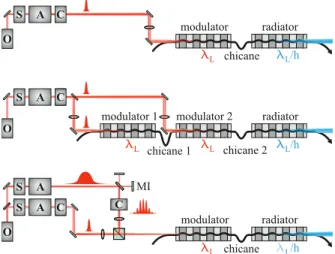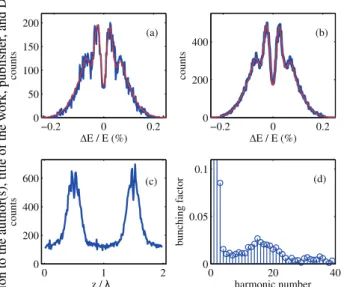A NEW METHOD TO GENERATE ULTRASHORT AND COHERENT PULSES OF SHORT-WAVELENGTH SYNCHROTRON RADIATION ∗
S. Khan † , Center for Synchrotron Radiation (DELTA), TU Dortmund University, 44227 Dortmund, Germany
Abstract
A laser-based method to generate ultrashort pulses of syn- chrotron radiation in electron storage rings is coherent har- monic generation (CHG) using two undulators to produce coherent radiation at harmonics of the initial laser wave- length by microbunching. The bunching factor and thus the pulse intensity, however, decreases exponentially with increasing harmonic order. Echo-enabled harmonic gener- ation (EEHG), proposed in 2009 as FEL seeding scheme, can be used to produce short synchrotron radiation pulses at higher harmonics, but requires three undulators in a straight section. In this paper, a less space-consuming method based on seeding with intensity-modulated laser pulses is intro- duced, which also has the potential of significant bunching factors at high harmonics.
INTRODUCTION
The advent of linac-based free-electron lasers (FELs) with extremely intense and ultrashort pulses in the femtosecond range has opened up new opportunities for time-resolved studies of ultrafast atomic phenomena. However, only four FELs with sub-visible wavelengths have yet been commis- sioned and they are essentially single-user facilities with 5- 120 bunches (or bunch trains) per second [1–4]. On the other hand, synchrotron light sources based on electron storage rings serve many users simultaneously with a typical bunch rate of 500 MHz and very stable beams, but the pulse dura- tion is 30-100 ps (FWHM). With more than 50 synchrotron light sources in operation worldwide [5], it is worthwhile to investigate methods to extend their capabilities towards shorter pulse duration and higher peak intensity.
In an electron storage ring, the synchrotron motion trans- lates a natural energy spread of typically σ
E≈ 10
−3E (rms) into a bunch length, depending on the radiofre- quency (RF) voltage and momentum compaction factor α ≈ (ΔL/L )/(ΔE/E) . A strong reduction of α at the ex- pense of bunch charge and beam emittance is used at several synchrotron light sources to shorten the bunches to a few picoseconds, see e.g. [6].
SHORT-PULSE GENERATION
Rather than shortening the bunches further, the femtosec- ond regime is more easily accessible by extracting syn- chrotron light from a short fraction, a “slice”, of the bunch.
A femtosecond laser pulse co-propagating with an electron bunch through an undulator (the “modulator”) tuned to the
∗
Work supported by BMBF (contract 05K13PE3).
†
shaukat.khan@tu-dortmund.de
Figure 1: Top: Coherent harmonic generation (CHG) using a laser-induced electron energy modulation in an undulator (’modulator’), converted to a density modulation in a chicane and coherent radiation in a second undulator (’radiator’).
Center: Echo-enabled harmonic generation (EEHG) based on laser-electron interaction in two modulators. Bottom:
New method with laser-electron interaction at different times in the same modulator. Also shown: laser oscillator (O), stretcher (S), amplifier (A), compressor (C), and Michelson interferometer (MI).
laser wavelength causes a sinusoidal modulation of the elec- tron energy within the bunch slice. Femtosecond laser pulses are typically generated by Ti:sapphire lasers at a wavelength of 800 nm (photon energy E
P= 1.55 eV). With a pulse energy E
Lin the mJ range (≈ 10
16eV) and a pulse duration around σ
L≈ 20 fs (rms), the modulation amplitude [7]
ΔE ≈ 0 . 2 E
LE
PM
U/M
L(1)
will exceed the natural energy spread of the electron beam.
The expression is valid as long as the number of undulator periods M
Uis smaller than the number of optical cycles M
L= 2 √
2 ln 2 c σ
L/λ
Lper FWHM pulse length.
One way to exploit the energy modulation in a second undulator (the “radiator”) is to transversely displace the off- energy electrons in dipole magnets, providing a spatial sep- aration between the short radiation component from the slice and the long component from the rest of the bunch [8–11]. Another method making use of the laser-induced en- ergy modulation is known as coherent harmonic generation (CHG) [12–15], see Fig. 1 (top). Here, a density modulation (microbunching) is created by energy-dependent path length differences in a magnetic chicane, allowing to generate co- herent radiation at harmonics of λ
Lin the radiator. The
6th International Particle Accelerator Conference IPAC2015, Richmond, VA, USA JACoW Publishing
ISBN: 978-3-95450-168-7 doi: 10.18429/JACoW-IPAC2015-TUPWA021
TUPWA021 1448
Content from this w ork ma y be used under the ter ms of the CC BY 3.0 licence (© 2015). An y dis tribution of this w ork mus tmaintain attr ibution to the author(s), title of the w ork, publisher ,and DOI.
2: Photon Sources and Electron Accelerators
A05 - Synchrotron Radiation Facilities
Figure 2: Schematic phase space diagrams, i.e., relative energy offset versus longitudinal coordinate in units of the seed wavelength for EEHG after (a) modulator 1, (b) chicane 1, (c) modulator 2, (d) chicane 2, and for DECHG showing the effect of (e) first modulation, (f) 1/4 synchrotron period, (g) second modulation, and (h) chicane. Note the different scales. The red triangle in (g) refers to Eq. 3.
radiation power at the hth harmonic is P = P
long+ P
short= P
en
long+ b
2hn
2short, (2) where P
eis the power emitted by one electron, n
longis the total number of electrons in the bunch, b
h=
k
exp (−i 2 πhz
k/λ
L) /n
shortis the bunching factor and z
kare positions of n
short≈ n
long/ 1000 coherently radiating electrons. With n
long= 2 . 4 · 10
10for a bunch current of 10 mA at the DELTA storage ring described below, a bunch- ing factor of b
h= 0.03 is sufficient to achieve a ratio of coherent and incoherent power P
short/P
long> 10, and no spatial separation is required. Since the bunching factor re- duces exponentially with harmonic number, the incoherent background limits h to values well below 10.
A possible extension of CHG to shorter wavelengths is echo-enabled harmonic generation (EEHG) proposed in 2009 as an FEL seeding scheme [16] and employing two modulators and a radiator as shown in Fig. 1 (center). As shown in longitudinal phase space in Fig. 2 (a-d), a strong chicane following the first modulator results in a phase space pattern with stripes of nearly constant energy. A second energy modulation, followed by another chicane, creates a density modulation which, in contrast to CHG, contains higher Fourier components. First EEHG proof-of-principle experiments were performed at SLAC in the USA [17] and SINAP in China [18].
A NEW LASER-BASED SCHEME
The essence of the EEHG scheme is to create stripes of discrete energy in phase space, which translate into narrowly spaced longitudinal fringes when subjected to a second en- ergy modulation and sheared by a chicane. However, the straight sections in most synchrotron light sources are not
Figure 3: Distribution of electrons in phase space (energy offset in percent of the beam energy E versus longitudinal coordinate z ), shown 1, 14 and 28 turns after a laser-induced energy modulation as shown in Fig. 2 (e).
long enough to accommodate three undulators with two chi- canes between them. For the case of SOLEIL in France, a scheme with the two modulators in different straight sec- tions was proposed [19] with the drawback of occupying two straight sections. Between them, nonlinearities and spurious r
51and r
52contributions tend to wash out the phase space pattern.
The scheme proposed in this paper aims at producing a pattern of discrete-energy stripes without using an addi- tional modulator and chicane. For brevity, it will be denoted as discrete-energy coherent harmonic generation DECHG), where “discrete” refers to an energy width much smaller than the natural energy spread.
Here, the modulator of a CHG setup is used to create an energy modulation with periodically varying amplitude over a large fraction of the bunch, as shown in Fig. 2 (e). Energy- dependent path-length differences along the storage ring convert this pattern into discrete density maxima which turn into discrete-energy stripes after a quarter of a synchrotron period (Fig. 3). Next, a femtosecond laser pulse induces a second energy modulation in the same modulator followed by a chicane. This leads to microbunches separated by λ
Las in the case of CHG, but now with a number of density fringes within each microbunch. Effectively, each microbunch can be viewed as an image of the initial density distribution demagnified from the bunch length σ
Bto a fraction of the laser wavelength. The rms length of the microbunches σ
MBis obtained by considering the triangle in Fig. 2 (g):
ΔE sin 2 πσ
Mλ
L≈ ΔE 2 πσ
Mλ
L= σ
E→ σ
M≈ σ
EΔE λ
L2π (3) with the amplitude ΔE of the second modulation given by Eq. 1. With a spacing of Δz between intensity maxima of the first laser pulse, the fringe spacing δz is then
δz = Δz σ
Mσ
B= σ
EΔE λ
L2 π Δz σ
B(4) and the corresponding harmonic number is h = λ
L/δz . The length of the coherent pulse emitted in the radiator is given by the second laser pulse of ultrashort duration. Alternatively, a longer laser pulse may be employed to produce pulses which are not ultrashort but exceed the pulse energy of conventional synchrotron radiation by orders of magnitude. Yet another option is to perform the second energy modulation with a
6th International Particle Accelerator Conference IPAC2015, Richmond, VA, USA JACoW Publishing
ISBN: 978-3-95450-168-7 doi: 10.18429/JACoW-IPAC2015-TUPWA021
2: Photon Sources and Electron Accelerators A05 - Synchrotron Radiation Facilities
TUPWA021 1449
Content from this w ork ma y be used under the ter ms of the CC BY 3.0 licence (© 2015). An y dis tribution of this w ork mus tmaintain attr ibution to the author(s), title of the w ork, publisher ,and DOI.


